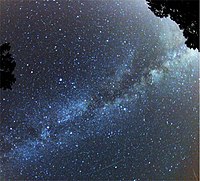
Photo from wikipedia
We aim to study the optical and near-infrared linear polarimetric properties of a sample of young M7-L7 dwarfs ($\approx$1-500 Myr) with spectroscopic signatures of low- and intermediate-gravity atmospheres. We collected… Click to show full abstract
We aim to study the optical and near-infrared linear polarimetric properties of a sample of young M7-L7 dwarfs ($\approx$1-500 Myr) with spectroscopic signatures of low- and intermediate-gravity atmospheres. We collected optical ($RIZ$) and near-infrared ($YJHK_{\rm s}$) linear polarimetry images on various time scales from $\sim$0.2 h to months. Linear polarization degrees in the interval 0-1.5\% ($I$- and $J$-bands) were measured with accuracies ranging from $\pm$0.1 $\%$ to $\pm$0.9 $\%$ depending on the observing filter and the target brightness. We found that the young field dwarfs in our sample show similar polarimetric degrees at both $I$- and $J$-bands, and that there is no obvious trend with the spectral type. The two Taurus sources in our sample show intense levels of $J$-band linear polarization probably due to surrounding disks. By compiling data from the literature for high-gravity M7-L7 dwarfs with likely ages $\ge$500 Myr, we did not observe any apparent difference in the linear polarimetry intensity between the young and old samples that could be ascribed to differing atmospheric gravities. Polarimetric variability with peak to peak amplitudes up to 1.5 $\%$ is detected on scales of about a rotation in two out of four targets that were monitored over several hours. Long-term polarimetric variability is also detected in nearly all dwarfs of the sample with data spanning months to years.
Journal Title: Monthly Notices of the Royal Astronomical Society
Year Published: 2017
Link to full text (if available)
Share on Social Media: Sign Up to like & get
recommendations!